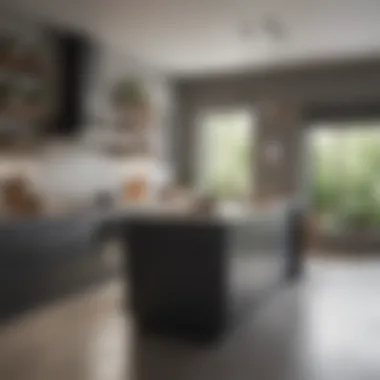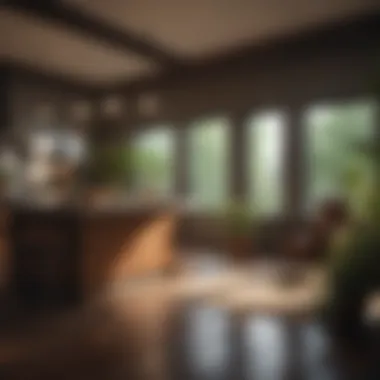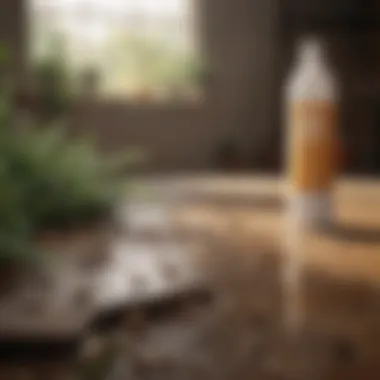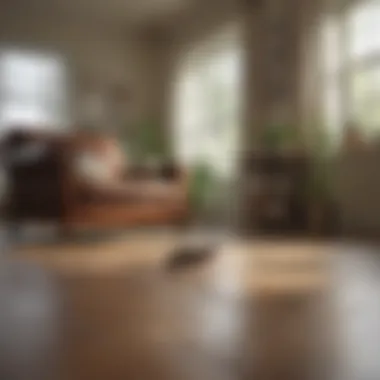Eliminating Roach Odor: A Comprehensive Guide


Intro
Dealing with a roach infestation can be a daunting task. Aside from the visual discomfort that these pests bring, their odor leaves a lasting negative effect on the indoor environment. The smell often comes from their droppings, urine, and even decomposing bodies. Understanding the source of this odor is essential for effective deodorization. The aim of this guide is to equip homeowners with practical methods to combat and eliminate these smells, ensuring a clean and fresh living space.
Causes of Roach Odor
The offensive scent associated with cockroaches originates from several factors. Primarily, the accumulation of roach droppings creates a musty and foul smell. When roaches die, their bodies also contribute to an unpleasant odor. Furthermore, their habits, like feeding on decaying matter, can introduce additional odors into a home.
Identifying Problem Areas
Identifying where the odor is most potent can help in addressing the issue effectively. Common areas include:
- Kitchens: Food residues attract cockroaches, leading to odor generation.
- Bathrooms: Moist environments are conducive to roach infestations, contributing to the smell.
- Basements: Dark and damp spaces often harbor pests.
Evaluating the Extent of the Infestation
Homeowners should assess how severe the infestation is. This can involve examining food sources or the presence of droppings. Severe infestations will require more intensive intervention.
Cleaning and Deodorizing Techniques
After identifying the source of the odor, a thorough cleaning and deodorizing process can begin.
Initial Cleaning Steps
- Remove Food Sources: Seal all food items in airtight containers. This will help in deterring further infestation.
- Vacuum Thoroughly: Use a vacuum to remove droppings and dust in affected areas. Focus on corners, baseboards, and under appliances.
- Clean Surfaces: Wipe surfaces with a mixture of water and vinegar or a mild detergent. This will kill some odors and remove residue.
Deodorization Methods
- Baking Soda: Place bowls of baking soda in problem areas. This substance neutralizes odors effectively.
- Essential Oils: Oils such as tea tree or peppermint can mask and deter cockroaches. Mix with water and spray in affected areas.
- Activated Charcoal: This is effective in absorbing odors. Place in open containers near problem areas.
"Effective cleaning can not only eliminate the odor but also discourage future infestations."
Preventive Measures
Taking proactive steps can prevent future odor issues related to roach infestations.
Regular Cleaning Routine
Maintain a regular cleaning schedule, including:
- Emptying Garbage Regularly: This reduces the chance of attracting cockroaches with food waste.
- Wiping Spills Immediately: Food residues lead to odors and attract pests.
Sealing Entry Points
Inspect and seal all cracks and crevices in walls, windows, and doors. This will help in preventing roaches from entering the home.
Monitoring Humidity Levels
Cockroaches thrive in damp conditions. Using a dehumidifier can help keep indoor humidity levels low, making the environment less hospitable for roaches.
Home Remedies to Deter Roaches
Homeowners can also use various home remedies to deter roaches:
- Borax: A natural insecticide that helps in killing roaches while also reducing odor.
- Soap and Water: A mixture can suffocate roaches on contact.
The End
Eliminating roach odor requires a strategic approach involving thorough cleaning and preventive measures. By understanding the sources and taking action, homeowners can restore freshness to their living environment. This guide serves as a comprehensive resource for anyone seeking to maintain a clean, odor-free home. By staying vigilant and proactive, it is possible to create a healthier indoor air quality, ultimately enhancing the overall living conditions.
Understanding Roach Odor


Understanding the odor associated with roaches is a vital part of managing home hygiene. Roach odor is not just an unpleasant nuisance; it can indicate a deeper problem related to the presence of these pests. Knowledge about roach odor can lead homeowners to take action before the issue escalates. Acknowledging the smell's significance can promote proactive measures in pest control and cleaning a home effectively.
Defining Roach Odor
Roach odor is often described as musty or oily. It stems from both the insects themselves and their droppings. The scent varies based on the species of roach, but most people find it irritating. When roaches are present, the scent can become increasingly strong, alerting homeowners to an infestation.
This smell arises during their movement and when they die. It is crucial not to overlook this odor, as it signals that immediate attention is needed to eliminate roaches and their effects on indoor air quality.
Causes of Roach Smell
The two primary causes of roach smell include their secretions and decaying bodies.
- Secretions: Roaches secrete pheromones that help them communicate, and these substances can produce a distinct smell.
- Waste: The feces of roaches contribute significantly to the odor. These droppings can hold moisture and become a breeding ground for bacteria, which can increase the foul smell.
- Decay: When roaches die, their bodies begin to decompose, releasing another layer of odor.
These elements combined create an unsettling atmosphere in any living space. Therefore, understanding these causes is essential for efficient odor elimination.
Identifying Roach Infestation
Identifying a roach infestation goes beyond simply detecting odor. Homeowners should consider several signs:
- Sightings: Spotting roaches, especially during the day, indicates a more significant issue. These creatures are primarily nocturnal.
- Droppings: Finding droppings in areas like kitchens and bathrooms is a strong indicator of their presence.
- Egg Capsules: Roaches lay eggs in brown, oval-shaped capsules. Discovering these egg cases suggests they are breeding nearby.
Monitoring these signs is essential for acting promptly against an infestation. By understanding these elements, homeowners can provide a cleaner, safer living environment.
Assessing the Scope of the Problem
Understanding the extent of roach odor and its sources is crucial in effectively eliminating the smell. Assessing the scope of the problem allows homeowners to prioritize actions and direct resources efficiently. It serves as the first step in crafting a strategic approach, ensuring that both immediate and long-term solutions are enacted.
Locating the Source of the Odor
Identifying the precise source of the odor is essential. The smell associated with roach infestations often stems from their fecal matter, shed exoskeletons, and even their secretions. To locate the source, one should conduct a systematic inspection.
- Check Common Hiding Spots: Look under sinks, behind appliances, and in dark corners of cabinets. These areas provide ideal habitats for roaches.
- Look for Signs of Infestation: Droppings, egg cases, and even dead roaches can indicate where the problem is concentrated. Spotting these signs is indicative of a severe presence.
- Follow the Odor: The stronger the smell, the closer you are likely to the source. Utilize your sense of smell to identify particularly pungent areas, which may require more immediate attention.
Taking note of multiple sources is key. It’s common to find several areas infected, and each should be addressed in the cleaning strategy.
Understanding the Severity of Infestation
Assessing the severity of the infestation plays a vital role in determining the complexity of the response.
- Severity Indicators: The number of sightings, evidence of droppings, and frequency of odor can help gauge the level of infestation. A higher quantity of these indicators necessitates a more intensive cleaning and deodorizing effort.
- Considering Health Risks: It is critical to understand that higher infestations not only produce more odor but also pose health risks. Roaches can carry pathogens that affect air quality and create allergic reactions in some individuals. Being aware of these risks can emphasize the urgency in addressing the problem.
- Long-term Implications: Allowing an infestation to grow can make elimination harder and the odors more entrenched. In some cases, the structural conditions can deteriorate. Thus, early detection and assessment are necessary for maintaining a livable environment.
Overall, assessing the scope of the problem creates a pathway to efficient and effective solutions. By understanding where the odors come from and how severe the situation is, homeowners gain the insight needed to tackle roach infestations effectively.
Initial Cleaning Strategies
Initial cleaning strategies are pivotal in addressing the unpleasant odors stemming from roach infestations. When a roach colony invades a home, they can leave a notable mark through their droppings, carcasses, and urine. These substances not only produce a foul smell but may also contribute to health issues. By implementing effective cleaning strategies at the outset, one can significantly diminish both the odor and the potential for further infestations. This section explores fundamental approaches and considerations that can help homeowners create a fresher living environment.
Basic Cleaning Techniques
The primary step in removing roach odor involves thorough cleaning. Begin by sweeping and vacuuming both visible and hidden areas in your home. Pay close attention to corners, under appliances, and behind furniture, as these areas are often neglected. Dispose of the vacuum bag or empty the container outside immediately to prevent any retained smells from returning.
Regular mopping of floors using a suitable detergent can remove residual odors. For surfaces, using disinfectant wipes on countertops and furniture is effective. Ensure that the cleaning is meticulous, covering all surfaces where roaches might have left their marks.
Consider creating a cleaning schedule. Consistency in cleaning can minimize the likelihood of new infestations and ensure that any lingering odors do not resurface.
Cleaning Products to Use
Selecting the right cleaning products is crucial in the fight against roach odor. Look for products specifically formulated to eliminate odors rather than merely masking them. Enzyme-based cleaners are effective as they target and break down organic compounds, neutralizing the source of the odor at a molecular level. Here are some recommended types of products:
- Enzyme Cleaners: Break down waste matter that could be contributing to smells.
- Disinfectants: Kill bacteria and pathogens associated with roach activity.
- Baking Soda: Known for its natural deodorizing properties, it can be sprinkled in affected areas before normal cleaning procedures.
Always follow the manufacturer's instructions for use to ensure effectiveness and safety. Additionally, when using any cleaning product, remember to ventilate the area to avoid inhaling strong fumes.


Disposing of Contaminated Materials
Disposal of contaminated materials is a critical yet often overlooked aspect of initial cleaning strategies. Any items contaminated with roach droppings, urine, or remnants must be handled carefully to prevent health risks and to eliminate odor. This might include discarded food, packaging, or even linens that have come into contact with roaches.
Begin the disposal process by safely packaging contaminated materials in plastic bags to avoid spreading contaminants. Seal these bags securely and place them in your outdoor trash receptacle immediately. Take extra care when handling items that may have fallen in hard-to-reach places.
It is vital to maintain proper hygiene while cleaning and disposing of these materials. Wearing gloves and a mask during the process can protect you from potential allergens and toxins.
Deodorizing Techniques
Deodorizing techniques are crucial when addressing the persistent and unpleasant smells caused by roach infestations. Effective deodorization not only helps in masking the odor but also aids in removing underlying sources of smells. Understanding various techniques can empower homeowners to create a more inviting living space and improve indoor air quality.
Natural Deodorizing Agents
Natural deodorizing agents are environmentally friendly options for combating roach odors without introducing harmful chemicals into the home. Common agents include baking soda, vinegar, and activated charcoal.
- Baking Soda: This simple kitchen staple absorbs odors and can be sprinkled in areas where roaches frequent. Leave it for a few hours before vacuuming, allowing it to neutralize the unwanted smell.
- Vinegar: White vinegar is an effective disinfectant and deodorizer. Creating a solution by mixing equal parts of vinegar and water can help wipe down surfaces where roaches may leave behind odors.
- Activated Charcoal: Known for its ability to trap odors, activated charcoal can be placed in open containers around the home. It works by absorbing lingering smells from the air.
These natural alternatives not only alleviate odor but also pose minimal risk to humans and pets, making them easy to integrate into cleaning routines.
Commercial Deodorizers
Commercial deodorizers offer a variety of solutions specifically designed to combat roach smells. They often contain advanced odor neutralizing technology. Options include sprays, gels, and plug-in devices. Here are a few notable types:
- Odor Eliminating Sprays: These products are designed to neutralize odor at the source rather than simply masking it. They can be used in areas that are difficult to access regularly, like behind appliances.
- Air Freshener Gels: These products release fragrances slowly over time and can be placed in strategic locations within a home. They continue to work even after initial application.
- Plug-In Odor Neutralizers: These devices are easy to use and can be plugged into any outlet. They typically release a controlled amount of deodorizing agents to manage odors continuously.
Using the right commercial deodorizer ensures that homeowners can effectively address roach odor for longer periods.
Odor Neutralizing Methods
Beyond natural and commercial deodorizers, there are various methods to neutralize odors effectively. Implementing these practices can significantly improve the freshness of your indoor environment:
- Regular Cleaning: Maintaining a regular cleaning schedule is vital. Vacuuming carpets and mopping floors can prevent odors from embedding into surfaces.
- Ventilation: Increasing air circulation through windows and exhaust fans helps remove stale odors. Fresh air is often the best remedy for lingering scents in your home.
- Essential Oils: Using essential oils such as tea tree or eucalyptus can mask and neutralize foul odors, promoting a pleasant scent. Diffusing these oils can also aid in disinfecting the air.
"Regular routines of cleaning combined with smart deodorizing techniques can make a significant difference in maintaining a fresh environment."
Preventive Measures
Preventive measures are crucial for combatting the persistent issue of roach odor. Taking proactive steps not only helps to eliminate existing odors but also significantly reduces the likelihood of infestations in the first place. This section will delve into important strategies, focusing on specific elements that can fortify your living space against these unwelcome guests.
Maintaining Clean Spaces
Keeping your living environment clean is the foundation of any effective pest control strategy. Roaches thrive in messes, feeding on leftover food particles, spilled liquids, and even the glue from cardboard boxes. Regular cleaning can greatly diminish the resources available to these pests.
Here are some practical tips for maintaining clean spaces:
- Regularly vacuum and sweep floors to pick up crumbs and debris.
- Wipe down surfaces in kitchens and dining areas daily with a disinfectant to remove residues.
- Store food properly in sealed containers. Don’t leave pet food out overnight.
- Clear clutter that might offer hiding places for roaches, such as stacks of newspapers, dirty dishes, and unused appliances.
Keeping clean will certainly aid in alleviating odors emanating from roach activity.
Implementing Pest Control Systems
Incorporating pest control systems is an essential aspect of preventing roach infestations. These systems can involve a combination of professional services and DIY solutions that create a formidable defense against cockroaches. Regular treatments can proactively eliminate the roach population before they create problems.
More commonly, a few methods to enhance pest control include:
- Using baits and traps that attract and kill roaches. Place these in strategic areas like under sinks, behind appliances, and in dark corners.
- Employing insecticidal sprays as a quick-response measure, ensuring you follow all safety guidelines.
- Engaging professional pest control services for more severe infestations. They will provide tailored solutions based on the specific conditions of your home.
Regular Inspections and Maintenance
Regular inspections play a crucial role in early detection and treatment of infestations. Examining your home at routine intervals can help you identify the signs of roach activity before they become a significant issue. A thorough assessment should focus on potential entry points, nests, and droppings.


Consider the following recommendations for effective inspections:
- Inspect plumbing for leaks. Roaches seek moisture and are often found near water sources.
- Check for gaps and cracks in walls, windows, and doors. Seal any openings that could serve as entry points.
- Keep an eye on high-risk areas such as kitchens, bathrooms, and basements where roaches commonly gather.
Adopting these measures fosters a preventive mindset that safeguards your indoor environment, ultimately contributing to a fresher, healthier living space.
Long-Term Solutions for Odor Elimination
Addressing the persistent odor that comes with roach infestations goes beyond immediate cleanup. Instead, long-term solutions focus on preventing roach odors from returning. It is essential for homeowners to understand that temporary fixes may mask the smell, but will not eliminate the underlying issues. Sustaining a fresh environment requires a deeper commitment to cleanliness and home structure.
Implementing durable solutions not only improves air quality but also contributes to overall comfort within the home. It includes consistent pest control measures, renovations that enhance livability, and regular assessments of the home’s condition.
Professional Pest Control Services
One of the most effective long-term solutions for tackling roach odors is engaging professional pest control services. These experts bring specialized knowledge and tools to address infestations comprehensively.
Benefits of Professional Services:
- Expert Assessment: Professionals can identify the extent of the infestation and its sources.
- Targeted Treatments: They utilize products that may not be available to the consumer, ensuring a more thorough elimination of the pests.
- Follow-Up Services: Many pest control companies offer follow-up services to ensure that the infestation does not return.
However, it is crucial to choose a reputable company that uses safe, environmentally friendly products. Poor choices may lead to more significant problems down the line, including harmful chemical exposure that may affect health.
"Investing in professional pest control not only eliminates the current issue but also reduces the risk of future infestations."
Renovations and Structural Changes
Another integral aspect of long-term odor elimination involves renovations and structural changes within the home. Many homes have nooks and crannies that can serve as hiding places for roaches. Addressing these vulnerabilities is key to a successful prevention strategy.
What to Consider:
- Sealing Cracks and Gaps: Ensure that all entry points, including cracks in walls and gaps around windows or doors, are sealed. This reduces the chances of future infestations.
- Upgrading Plumbing and Electrical Systems: Sometimes, roaches are attracted to moisture. Upgrading old or leaking pipes can help eliminate damp areas that attract pests.
- Flooring and Wall Renovations: Consider using materials resistant to moisture and easy to clean. This not only minimizes food sources for roaches but also simplifies cleaning routines.
Renovations might require initial investments, but the long-term benefits include less maintenance, improved indoor air quality, and a decrease in unpleasant odors.
Creating a consistent approach towards home maintenance will solidify the efforts to eliminate roach odors, resulting in a healthier living environment.
Monitoring and Assessment
Monitoring and assessment are critical components in the quest to eliminate roach odor. This section underscores the need for ongoing vigilance and adaption in the face of a potentially serious infestation. Regular monitoring allows homeowners to track the effectiveness of their odor elimination strategies, thus ensuring continual improvement in their living environment. It emphasizes the importance of recognizing when adjustments are necessary, preventing the progression of odors and the return of cockroaches.
"An effective monitoring system can significantly reduce the chance of reinfestation and maintains the freshness of indoor air."
Tracking Improvement Over Time
The process of tracking improvement is essential for gauging the success of odor elimination efforts. Homeowners should establish a baseline. This means identifying the initial intensity and frequency of roach odor concerns. Keeping a journal or log may be beneficial, as it enables monitoring specific changes. Key indicators to observe include:
- Intensity of Odor: Regularly assess if the smell is diminishing or remaining constant.
- Frequency of Occurrences: Note how often the odor presents itself, especially after cleaning efforts.
- Changes in Roach Activity: A marked decrease in cockroach sightings indicates a positive trend.
Tools like air quality monitors can assist in this measurement, providing an objective assessment of indoor air quality.
Adjusting Strategies as Needed
Adjustment of strategies becomes necessary when tracking shows no improvement or if odors persist. It is an inevitable element of effective pest control and odor elimination. After analyzing the data collected, consider the following:
- Review Cleaning Techniques: If certain cleaning methods do not yield results, explore alternatives that may be more effective.
- Evaluate Pest Control Measures: Consult with pest control professionals to consider new methods if infestations continue.
- Enhance Preventive Practices: Incorporate additional preventive measures such as sealing entry points or improving sanitation practices.
Regular assessments should lead to proactive adaptations. This not only eliminates odors but also creates a healthier living space, improving overall indoor air quality.
Culmination
In summation, addressing roach odor is a critical concern for any homeowner. The implications of a roach infestation extend beyond mere aesthetics; they affect air quality and overall well-being. Ignoring the signs can lead to larger infestations, further complicating eradication efforts and exacerbating unpleasant odors.
This article has highlighted key aspects of roach odor, from understanding its sources to developing effective cleaning and deodorizing strategies. The emphasis on preventive measures ensures that your living space remains free from the clutches of pests.
Summary of Key Points
- Understanding Roach Odor: Roach smell results from the secretion of certain chemicals and decomposition of their bodies. Recognizing its presence is crucial in early detection.
- Assessing the Scope of the Problem: Identifying the source of the odor and evaluating the severity of the infestation allow for targeted interventions.
- Initial Cleaning Strategies: Basic cleaning and appropriate disposal of contaminated materials are essential first steps in odor elimination.
- Deodorizing Techniques: Implementing both natural and commercial solutions can significantly reduce the unpleasant smell.
- Preventive Measures: Maintaining cleanliness, a robust pest control system, and regular inspections are vital in preventing future infestations.
- Long-Term Solutions: Professional pest control services and potential renovations can offer lasting relief from odors.
- Monitoring and Assessment: Continuous tracking of improvement and adjusting strategies ensures the effectiveness of implemented solutions.
"Removing and preventing roach odor not only improves your home environment but also contributes to better health for all residents."







